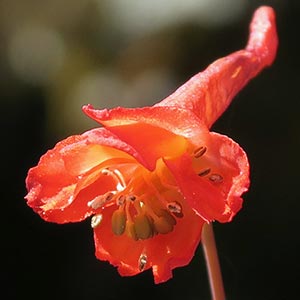Delphinium nudicaule
Delphinium andesicola
canyon delphinium, canyon larkspur, orange larkspur, red larkspur, red or orange larkspur, scarlet larkspur
Chiricahua Mountain larkspur
(15-)20-50(-125) cm;
base reddish, glabrous.
60-200 +cm;
base reddish or not, glabrous, glaucous.
blade round to pentagonal, 2-6 × 3-10 cm; ultimate lobes 3-12, width 5-40 mm (basal), 2-20 mm (cauline).
blade cordate to semicircular, 5-8 × 5-12 cm, nearly glabrous; ultimate lobes 5-16, width 3-20 mm, tips gradually tapered to mucronate apex;
midcauline leaf lobes more than 3 times longer than wide.
5-20(-69)-flowered;
pedicel (1.5-)2-6(-8) cm, glabrous to glandular-pubescent;
bracteoles 14-20(-30) mm from flowers, green to red, linear, 2-4(-9) mm, glabrous to puberulent.
20-80-flowered;
pedicel 1-2(-3) cm, puberulent;
bracteoles 1-3 mm from flowers, green to brown, linear-lanceolate, 3-6 mm, puberulent.
sepals scarlet to reddish orange, rarely dull yellow, glabrous, lateral sepals forward-pointing to form pseudotube, (6-)8-13(-16) × 3-6 mm, spurs straight, slightly ascending, (12-)18-27(-34) mm;
lower petal blades elevated, exposing stamens, 2-3 mm, clefts 0.5-1 mm;
hairs sparse, evenly dispersed, yellow.
sepals purple, puberulent, lateral sepals spreading, 9-12 × 5-7 mm, spurs ascending ca. 45°, curved downward apically, purple, 10-13 mm, blunt tipped;
lower petal blades ± covering stamens, 4-6 mm, clefts 1.5-2.5 mm;
hairs centered, densest on inner lobes near base of cleft, white.
13-26 mm, 3.5-4.5 times longer than wide, glabrous.
12-15 mm, 3.5-4 times longer than wide, sparsely puberulent.
unwinged or sometimes slightly wing-margined;
seed coat cells with surfaces smooth.
unwinged;
seed coat cells elongate, surfaces pustulate.
= 16.
= 16.
Delphinium nudicaule
Delphinium andesicola
Delphinium nudicaule hybridizes with most other taxa of Delphinium that it encounters. Apparent hybrids involving D. nudicaule, and seen by the author (either afield or as specimens), include D. andersonii, D. antoninum, D. decorum, D. luteum, D. nuttallianum, D. patens, and D. trolliifolium. In addition, garden-grown plants have been hybridized with D. cardinale, D. elatum, D. menziesii, D. parishii, D. penardii, D. tatsienense Franchet, D. triste Fischer ex de Candolle, and D. uliginosum; D. nudicaule does not naturally occur with these species. Delphinium nudicaule is one of the earliest larkspurs to flower in any given locality. Douglas's type collection of D. nudicaule represents plants (synonyms D. sarcophyllum Hooker & Arnott and D. peltatum Hooker, an invalid name) grown under very moist conditions, probably quite near the ocean. The type specimen of D. armeniacum A. Heller represents plants grown under unusually dry conditions.
The Mendocino Indians consider Delphinium nudicaule a narcotic (D. E. Moerman 1986).
(Discussion copyrighted by Flora of North America; reprinted with permission.)
Delphinium andesicola, the westernmost representative of the southern Cordilleran complex, is found in the Chiricahua, Huachuca, Graham, and White mountains. Hybrids with Delphinium scopulorum are known.
(Discussion copyrighted by Flora of North America; reprinted with permission.)


